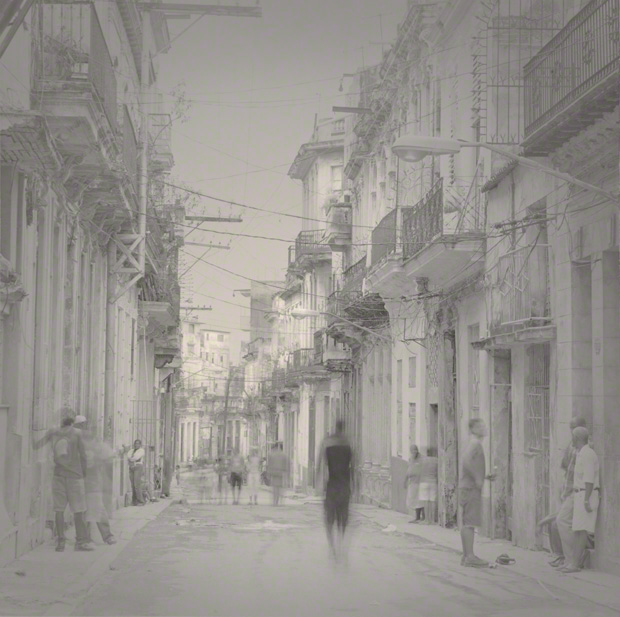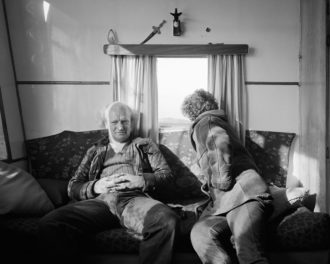What drew them to Cuba? We asked photographers Alex Harris, Virginia Beahan, and Alexey Titarenko, whose work is featured in the exhibition A Revolutionary Project: Cuba from Walker Evans to Now, to talk about what took them to the island, and what they found there.
Alex Harris
People often ask Alex Harris what he wanted to say when he first went to Cuba in 1998. “I wanted to see what the pictures would tell me,” he counters. “The camera says more than I know.”
Harris chose three icons of the island—the American car, the beautiful woman, and the revolutionary hero—as metaphors to explore the distortions with which Cubans and Americans see one another. Harris’s car photos, for example, capture a view of Cuba through the American lens: imported U.S. cars that literally frame the way Cubans see their island.

Fomento Between Calzada de Luyanó and Rodríguez, Luyanó, Havana, Alex Harris, negative, october 11, 2002; print, December 2007. Chromogenic print, 30 1/16 x 37 1/2 in. The J. Paul Getty Museum, 2010.90.10. Gift of Michael and Jane Wilson, Wilson Centre for Photography © Alex Harris
A former student of Walker Evans, who spent several weeks in Cuba at age 29, the island was perhaps a natural destination for Harris. “One of the things that gave me the chutzpah to go to Cuba was the fact that Evans went there in 1933 knowing even less than I did,” he said.
Audio: Interview with Alex Harris
Taped in the galleries; please excuse the background noise.
Download (MP3 file, 7.9 MB) | Length: 8:31
Virginia Beahan
Virginia Beahan saw Cuba for the first time in 2001, but had been interested in the island since her visit to Miami’s Little Havana in the ‘80s. A landscape photographer, she was struck by the signs of history that dotted the terrain, and “how present the sense of history was made to everyone who came to Cuba.”
She was particularly drawn to the roadside billboards that advertised the Revolution, such as this depiction of two revolutionary giants, Che Guevara and Camilo Cienfuegos.
By contrast, she found history all but erased at the Bay of Pigs, site of the failed U.S.-backed counter revolution in 1961. “I have a vivid imagination, and I’d hoped to find something dramatic, like a crashed American airplane,” she admitted. Instead, there was black coral, a metal ladder—and a beautiful sunset over the sea, which she captured in a 12-minute exposure.

Bahía de Cochinos (Bay of Pigs), Site of the April 17, 1961, CIA-Sponsored Invasion by Cuban Exiles, Virginia Beahan, 2004. Chromogenic print, 34 x 41 in. Wilson Centre for Photography. © Virginia Beahan
“The picture relies on a meeting of the viewer and the photograph,” she explained. Its meaning comes from what you “might begin to imagine about history, about storytelling, and about the specific place.”
Audio: Interview with Virginia Beahan
Taped in the galleries; please excuse the background noise.
Download (MP3 file, 5.2 MB) | Length: 5:35
Alexey Titarenko
Alexey Titarenko was drawn to Cuba in 2003 following years spent photographing his home town of Saint Petersburg—like Havana, a once-grand city transformed by revolution and slow decay under Communist rule.
“I was trying to find out what Cubans’ experience was,” he said, “and how the outside world could feel the same way by looking at my images.” Against a grey atmosphere with striking light, ghostly figures go about everyday tasks—gathering water at a tank, helping a neighbor repair his car, playing an impromptu game of ball.

Untitled (Havana), Alexey Titarenko, 2006. Gelatin silver print, 16 3/4 x 16 1/2 in. The J. Paul Getty Museum, 2010.70.2. © Alexey Titarenko
By employing a slow shutter speed, Titarenko deliberately rendered his subjects generalized and universal. “If you’re in a place that is lost in time, showing people who wear exactly the same clothing you wear here in Los Angeles or in Europe pushes you out” of the photograph, he told us. “When there are a lot of details, we spend our attention on them, instead of on the place as a whole.”
Text of this post © J. Paul Getty Trust. All rights reserved.
(Video and audio by Steve Saldivar)




Comments on this post are now closed.
Trackbacks/Pingbacks